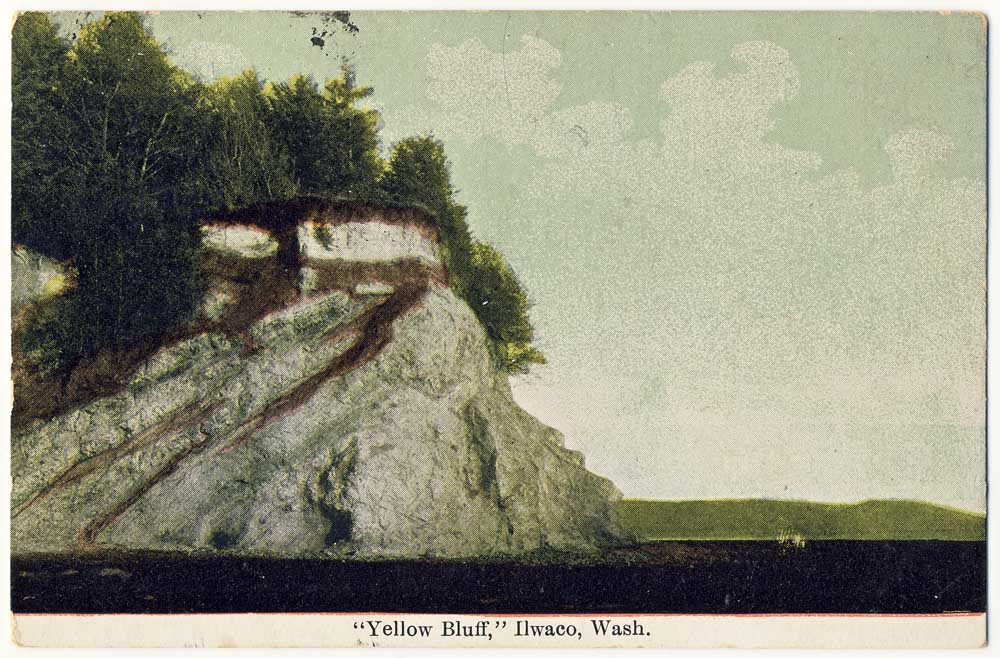Saints or Sinners? Characters of Pacific County: Mysteriously rich captain ‘swallows the anchor’
Published 8:27 am Sunday, July 14, 2024

- Yellow Bluff was once a prominent navigation landmark, guiding sailing ships into Baker Bay. Now much eroded, its remnants stand just southeast of Ilwaco City Park.
James Johnson (1805-1855)
The year was 1845 that Capt. James Johnson arrived in our area ready to “swallow the anchor” as seafaring men of the day described their desire to retire. His first sight of Bakers Bay overlooked by Yellow Bluff just beyond the Columbia River Bar stayed firmly in mind as he completed his voyage up the river. As master of a Hudson Bay Company ship, he delivered his cargo of Hawaiian island natives who would work for the company and live in the Kanaka Village established near Fort Vancouver.
With his mission completed, Johnson lost no time in returning to Balers Bay, establishing himself at a bar pilot. He built a neat, white-painted house facing the beach — the first in the area that would eventually become Ilwaco. His land extended up the ridge and encompassed Black Lake which then and for many subsequent years was known as Johnson’s Lake. Three other whites were then living on the bay, widely separated from one another — John Pickernell, William Edwards, and William McCarty. Each was somewhat of an enigma, and the rumors surrounding Johnson were particularly intriguing,
That Johnson had money, seemed to be a fact. However, how it had been acquired and where it was hidden were subjects of speculation for many years. One report was that he had “recovered” $20,000 in $50 gold slugs from a shipwreck. J.D. Holman, a later neighbor of Johnson’s, said that he had been asked by the old captain to measure his gold. Accordingly, Johnson delivered it to him for that purpose in elk skin bags — one bag at a time — from some place deep in the woods. According to Holman, the slugs varied in weight but the total agreed with the rumored sum.
Other stories hinted that Johnson had commanded a vessel from the East Coast to California where a gold cargo was taken aboard. But before the treasure could be delivered, the ship was “conveniently” wrecked and Johnson had absconded with the treasure. Various versions of that story were told and re-told, the most widely believed involving a shipwreck on the Columbia River with local Indians ending up with the gold. According to that particular version, Johnson (illegally) sold cheap whisky to the Indians in exchange for the gold — presumably an ounce of gold for a pint of “joy juice” — keeping the tribesmen in a state of inebriation until the gold had been fully extracted.
By Nov. 21, 1850, when U. S. Marshall (and former Mountain Man) Joseph L, Meek arrived in his capacity as United States Federal Census-Taker, he found on Bakers Bay, in House No. 147: James Johnson, Age 45, Pilot, Born in Scotland; Jane Johnson, age 30 (Indian) born in Oregon Territory; George Johnson, Age 6 (1/2 Indian) born in Oregon Territory,James Johnson, Jr. Age 3 (1/2 Indian) born in Oregon Territory;Mr. Sarbridge, Age 25, Carpenter.
The 1850 Farm Census showed that Johnson owned five improved acres with an appraised value of $1,000; implements and machinery, $250; and a produce inventory of 300 bushels of peas, beans and potatoes.
The only other “official record” of Capt. Johnson’s homestead on Baler Bay on Nov. 16, 1851 describes a visit by L.N. Blanchet, Archbishop of Oregon City. It was recorded in “the Catholick Book of the Catholick Mission at Fort George or Astoria” and, at one time. the book was located in the Pacific County Auditor’s Office.
In late October 1855, Capt. Johnson was drowned along with two other men while they were crossing the Columbia. Since Johnson’s wife had predeceased him by several years, his two young sons lived with various friends around the bay area, eventually moving to Oysterville — George a well-respected boat builder and Jimmy. an accomplished sailor and mail carrier throughout the Shoalwater region.
Capt. Johnson’s house and property were purchased from his estate by Isaac Whealdon in 1858 for $1,000. As for the gold that Johnson had supposedly secreted in the nearby woods — it was never located although treasure-hunters searched diligently for many years. The story, like that of Captain Scarborough’s treasure, remains one of the intriguing mysteries of early settlement in the Ilwaco area.









